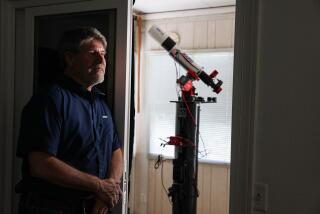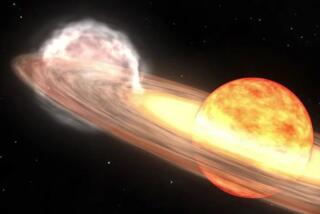Celestial Show Expected From Meteor Storm
- Share via
Professional and amateur astronomers throughout Southern California and the world will be up early Tuesday to view what many believe will be one of the most significant meteor storms of this century.
Local observers in dark locations may be able to see about 60--perhaps even hundreds--of meteors per hour.
Most of the particles will burn up more than 60 miles above Earth, posing no danger to earthbound observers. The hundreds of satellites orbiting above the atmosphere, however, will be sandblasted by the thousands of particles hurtling through space.
The Leonid meteors, so named because they seem to emanate from the constellation Leo, will make their annual November appearance in the predawn hours Tuesday and Wednesday. The meteors will appear in a moonless sky that will afford watchers in dark areas nearly ideal viewing conditions, if the weather cooperates.
Local viewing, however, won’t compare to that in northeastern China, Mongolia and Japan, areas where scientists are expecting thousands of meteors to pass overhead.
“In Southern California, the best we can do is get up around 4 on the morning of the 17th and hope for the best,” said Jet Propulsion Laboratory astronomer Donald Yeomans, a foremost authority on the Leonids.
“Unless Mother Nature has a surprise in store for us, in perfect conditions we might see on the order of one per minute if we’re lucky. If we were in Japan or China, it will be about a hundred times that, or more,” he added.
The Leonid meteors are the product of Comet Tempel-Tuttle, which orbits the sun once every 33 years. Every November, Earth’s orbit intersects Comet Tempel-Tuttle’s orbit, passing through debris thrown off by the comet. In most years, this results in an average Leonid shower of about 15 or 20 meteors per hour.
But every 33 years, the comet makes a particularly close pass by Earth. The result is an often spectacular meteor storm of thousands of meteors per hour. This year affords such an opportunity for viewers in East Asia.
The particles, many less than the diameter of a human hair and moving toward Earth at speeds of up to 45 miles per second, can damage the electronics of delicate instruments or punch holes in solar panels.
The threat to satellites, while minimal, is being taken seriously by the owners and operators of these multimillion-dollar instruments.
Operators such as NASA, Intelsat, the Aerospace Corp. and the U.S. Air Force will angle solar panels on satellites to be edge-on to the particles; they will power-down sensitive electronics to avoid the possibility of an electrical short; and satellites will be rotated away from the storm to protect sensitive equipment.
“The problem is not so much that the satellite will have a hole punched in it; the more likely event will be a charged particle that can cause electrical problems,” said William Ailor, director for the Center of Orbital and Reentry Debris Studies at the Aerospace Corp. in El Segundo.
“These are the fastest meteors that we know of,” he said. The velocity of the small particles is almost 100 times faster than a bullet shot from a rifle, he added.
NASA’s scientists will rotate the Hubble Space Telescope so that its back end will be facing the particle stream.
“With Hubble, even if a small particle hits that mirror, that could cause problems,” Ailor said.
Even the crew aboard Russia’s Mir Space Station will be taking precautions. “There is very little chance of any one of these particles doing damage to Mir, but just in case, they will be in an escape capsule during the storm,” Yeomans said.
Well before satellites, space stations and space telescopes, the Leonids sparked human interest. The earliest recorded appearance goes back more than 1,000 years, to AD 902, when witnesses reported that “stars fell like rain.”
The last time Comet Tempel-Tuttle passed close by Earth in its orbit was 1966. Scientists estimated that as many as 100,000 to 150,000 meteors per hour were seen over the southwestern United States at the peak of that storm.
An even more dramatic showing occurred in 1833. Agnes Clerke, an astronomy writer of the time, estimated that as many as 240,000 meteors were seen in the nine hours they fell over the eastern United States.
That Leonid storm was also characterized by giant fireballs that streaked across the sky, some so intense they cast shadows and left persistent smoke trails miles long, according to witnesses’ accounts.
Astronomers and other scientists throughout the world will be watching for the Leonids this week. Live Internet Web-casts from East Asia are planned. The National Science Foundation will send up two research aircraft carrying new scientific instruments to observe the Leonids on Tuesday.
All this activity may only be a precursor to 1999, however, which some scientists expect to be even better. The Leonids will be most readily visible over Europe then.
“This year and next year will be the best opportunities to observe the Leonids for several millennia,” Yeomans said.





